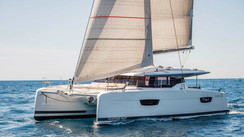The pressurized seawater (above osmotic pressure: 30 bar/435 psi in the Atlantic and 35 bar/500 psi in the Mediterranean) is forced to pass through these membranes, which only allow water molecules to pass through while retaining the molecules of salt and other minerals. At the end of the process, one liter of fresh water is obtained for every 10 liters of salt water absorbed, the excess brine water being pumped back into the sea. As the low-pressure seawater pump has to operate continuously, it is advisable to ensure the level of charge of the batteries, and preferably to operate the watermaker while recharging under engine or when connected to shore power. Nevertheless, there is a constraint linked mainly to the frequency of use. Composite membranes are vulnerable to fouling. It is therefore advisable to run the watermaker on a regular basis (even for short periods of time) in order not to let seawater stagnate in the system. If this happens, bacteria can flourish and eventually clog the pores of the membranes. After a shutdown of less than three days in tropical waters, or one week in temperate waters, the unit can be restarted straight away. After that and up to one or two months, depending on the sailing area, you’ll need to rinse the unit with water from the tanks in order to evacuate any residual seawater and leave only fresh water in the watermaker.
However, after this time period, in addition to rinsing, you must run clear water mixed with chemical solutions, first alkaline and then acidic through the unit, followed by a final rinse before reuse. This operation is sufficiently demanding to motivate the user to run their equipment with a simple rinse every two months. In some cases, such as winterization, time constraints mean that this is not always possible. In this case, you need to prepare for a long shutdown. After the chemical cleaning, a biocide is injected into the circuit (this is usually provided in the maintenance kits). These products prevent the bacterial fauna from developing, and the device can remain non-operational for a year. After one year, you will have to restart it by rinsing the tanks with water. Apart from these precautions, routine maintenance consists of cleaning the strainer (when your boat is out of the water for bottom paint), the 40-micron pre-filter and finally the 5-micron filter, which should be replaced when it is dirty. Avoid drawing from water containing hydrocarbons - these may damage the membrane. We cannot recommend this maintenance enough, as the replacement cost of used membranes is prohibitive.
We have monitored the ...
 Vote for your favorite multihulls!
Vote for your favorite multihulls! 





What readers think
Post a comment
No comments to show.